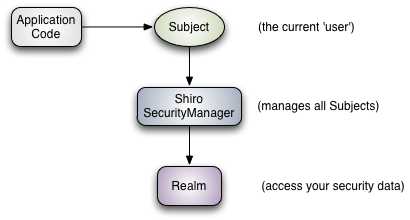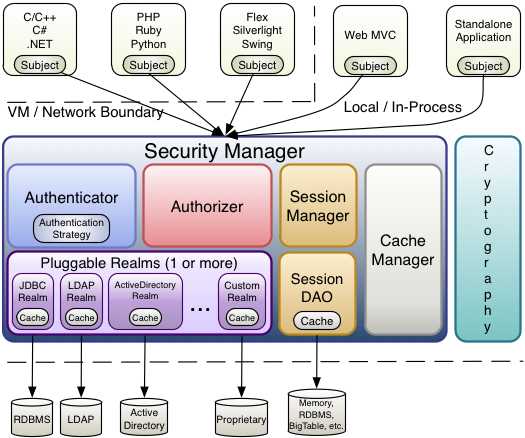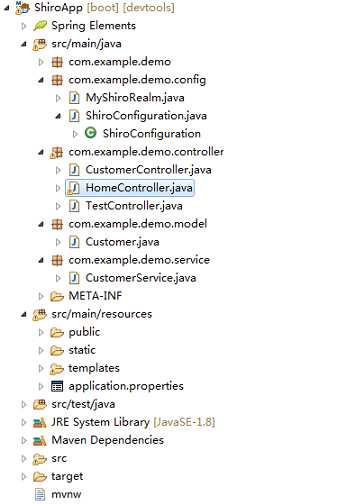SpringBoot集成Apache Shiro
Posted sankt
tags:
篇首语:本文由小常识网(cha138.com)小编为大家整理,主要介绍了SpringBoot集成Apache Shiro相关的知识,希望对你有一定的参考价值。
笔者因为项目转型的原因,对Apache Shiro安全框架做了一点研究工作,故想写点东西以便将来查阅。之所以选择Shiro也是看了很多人的推荐,号称功能丰富强大,而且易于使用。实践下来的确如大多数人所说简约优美,小巧精悍。
介绍demo项目前,简单说明一下Shiro框架的特性。
1. Apache Shiro Features
从上图可以看出Shiro具备应用程序安全框架的四大基石”:身份验证、授权、会话管理和密码。
Authentication:有时被称为‘登录’,这是需要明确用户是谁
Authorization:访问控制,即确定‘谁’对‘什么’有访问权限。
Session Management:管理特定用户的会话,即使在非web或EJB应用程序中也是如此。
Cryptography:使用加密算法保持数据安全,但易于使用。
在不同的应用程序环境中,还有更多的特性来支持和增强这些关注点,特别是:
Web Support:Shiro的Web支持API帮助轻松地保护web应用程序。
Caching:缓存是ApacheShiro的API中的第一等公民,以确保安全操作同时保持快速和高效。
Concurrency:ApacheShiro支持具有并发特性的多线程应用程序。
Testing:提供测试支持,以帮助编写单元和集成测试,并确保代码如预期的安全。
Run as:允许用户假定另一个用户的身份(如果允许的话)的特性,有时在管理场景中很有用。
Remember Me:记住用户在会话中的身份,这样他们就只需要在强制的情况下输入口令登录。
2. High-Level Overview
Shiro的体系结构有三个主要概念:Subject、SecurityManager和Realms。下图展现了它的运行原理,

主题:主题本质上是当前正在执行的用户。虽然“用户”这个词通常意味着一个人,一个主题可以是一个人,但它也可以代表一个第三方服务、守护进程帐户、cron作业或任何类似的东西-基本上是任何当前与软件交互的东西。Subject实例都绑定到(并且需要)一个SecurityManager。当与主题交互时,这些交互转化为与SecurityManager的特定主题交互。
SecurityManager:SecurityManager是Shiro体系结构的核心,它将其内部安全组件协调在一起形成一个对象图。然而,一旦为应用程序配置了SecurityManager及其内部对象图,它通常会被单独使用,应用程序开发人员将几乎所有的时间都花在Subject API上。当与一个主题交互时,实际上是幕后的SecurityManager为任何主题安全操作做了所有繁重的工作。
领域:领域充当Shiro和应用程序安全数据之间的“桥梁”或“连接器”。当涉及到实际与用户帐户等安全相关的数据交互以执行身份验证(登录)和授权(访问控制)时,Shiro从一个或多个为应用程序配置的领域中查找数据。从这个意义上说,领域本质上是一个特定于安全的DAO:它封装数据源的连接细节,并根据需要将相关数据提供给Shiro。配置Shiro时,必须指定至少一个用于身份验证和/或授权的域。SecurityManager可以配置多个Realm,但至少需要一个。Shiro提供了开箱即用的领域,以连接到许多安全数据源(也称为目录),如LDAP、关系数据库(JDBC)、INI和属性文件等文本配置源。
3. Detailed Architecture

4. 过滤器
当 Shiro 被运用到 web 项目时,Shiro 会自动创建一些默认的过滤器对客户端请求进行过滤。以下是 Shiro 内置过滤器:
|
过滤器简称 |
对应的 Java 类 |
|
anon |
org.apache.shiro.web.filter.authc.AnonymousFilter |
|
authc |
org.apache.shiro.web.filter.authc.FormAuthenticationFilter |
|
authcBasic |
org.apache.shiro.web.filter.authc.BasicHttpAuthenticationFilter |
|
perms |
org.apache.shiro.web.filter.authz.PermissionsAuthorizationFilter |
|
port |
org.apache.shiro.web.filter.authz.PortFilter |
|
rest |
org.apache.shiro.web.filter.authz.HttpMethodPermissionFilter |
|
roles |
org.apache.shiro.web.filter.authz.RolesAuthorizationFilter |
|
ssl |
org.apache.shiro.web.filter.authz.SslFilter |
|
user |
org.apache.shiro.web.filter.authc.UserFilter |
|
logout |
org.apache.shiro.web.filter.authc.LogoutFilter |
项目中常用的解释一下,
/test/**=anon ~~所有url 可以匿名访问
/test/**=authc ~~url需要认证才能访问
/test/**=perms[user:add] ~~url需要认证用户拥有 user:add 权限才能访问
/test/**=roles[admin] ~~url需要认证用户拥有 admin 角色才能访问
/test/**=user ~~url 需要认证或通过记住我认证才能访问
5. DEMO
开发工具为Eclipse+Maven,新建Springboot项目,版本号为1.5.14
模板引擎使用Thymeleaf
为了突出shiro,数据访问层略过,服务层模拟查询数据,Realm里面硬编码权限和角色信息简化代码。
整个系统的核心在于两个class(MyShiroRealm + ShiroConfiguration), 项目结构如下,

5.1 在pom.xml里面添加好shiro-core, shiro-spring,
<dependency>
<groupId>org.apache.shiro</groupId>
<artifactId>shiro-core</artifactId>
<version>1.4.0</version>
</dependency>
<!-- shiro权限控制框架 -->
<dependency>
<groupId>org.apache.shiro</groupId>
<artifactId>shiro-spring</artifactId>
<version>1.4.0</version>
</dependency>
5.2 显示层
模板引擎Thymeleaf,故application配置文件如下:
1 spring.thymeleaf.cache=true 2 spring.thymeleaf.prefix=classpath:/templates/ 3 spring.thymeleaf.suffix=.html 4 spring.thymeleaf.mode=HTML5 5 spring.thymeleaf.encoding=UTF-8 6 spring.thymeleaf.content-type=text/html
5.3 显示层静态页面如下:
403.html
add.html
delete.html
details.html
edit.html
index.html
login.html
logout.html
5.4 几乎所有静态页面就是一个空壳,大体如add.html

1 <!DOCTYPE html> 2 <html> 3 <head> 4 <meta charset="UTF-8"></meta> 5 <title>Add Page</title> 6 </head> 7 <body> 8 <h1>Add Page</h1> 9 </body> 10 </html>

1 <!DOCTYPE html> 2 <html> 3 <head> 4 <meta charset="UTF-8"></meta> 5 <title>Login Page</title> 6 <style type="text/css"> 7 table { 8 width: 360px; 9 min-height: 25px; 10 line-height: 25px; 11 text-align: center; 12 border-color: #b6ff00; 13 border-collapse: collapse; 14 15 } 16 </style> 17 </head> 18 <body> 19 <div> 20 <form action="/home/check" method="post"> 21 <table border="1"> 22 <tr> 23 <th>User Name</th> 24 <th><input type="text" name="name" /></th> 25 </tr> 26 <tr> 27 <td>Password</td> 28 <td><input type="password" name="password" /></td> 29 </tr> 30 <tr> 31 <td><input type="submit" value="Submit" /></td> 32 <td></td> 33 </tr> 34 </table> 35 </form> 36 </div> 37 </body> 38 </html>

1 <!DOCTYPE html> 2 <html> 3 <head> 4 <meta charset="UTF-8"></meta> 5 <title>Index Page</title> 6 <style type="text/css"> 7 p { 8 font-family: Times, TimesNR, ‘New Century Schoolbook‘, Georgia, 9 ‘New York‘, serif; 10 font-size: 20px; 11 } 12 </style> 13 14 </head> 15 <body> 16 <h1>This is index page.</h1> 17 <p> 18 Customer Name: <span th:text="${name}"></span> --- Role: <span 19 th:text="${role}"></span> 20 </p> 21 <table border="1"> 22 <tr> 23 <th>角色</th> 24 <th>权限</th> 25 </tr> 26 <tr> 27 <td>admin</td> 28 <td>增加,删除,编辑,查看</td> 29 </tr> 30 <tr> 31 <td>operator</td> 32 <td>编辑,查看</td> 33 </tr> 34 <tr> 35 <td>viewer</td> 36 <td>查看</td> 37 </tr> 38 </table> 39 <ul> 40 <li><a th:href="@{/customer/index}">Index</a></li> 41 <li><a th:href="@{/customer/details}">Details</a></li> 42 <li><a th:href="@{/customer/add}">Add</a></li> 43 <li><a th:href="@{/customer/edit}">Edit</a></li> 44 <li><a th:href="@{/customer/delete}">Delete</a></li> 45 </ul> 46 </body> 47 </html>
5.5 Model

public class Customer implements Serializable { private static final long serialVersionUID = 7429292944316962328L; private String name; private String password; private String role; public String getName() { return name; } public void setName(String name) { this.name = name; } public String getPassword() { return password; } public void setPassword(String password) { this.password = password; } public String getRole() { return role; } public void setRole(String role) { this.role = role; } public Customer(String name, String password, String role) { super(); this.name = name; this.password = password; this.role = role; } @Override public String toString() { return "Name : --- " + name + ", Password : --- " + password + ", Role : *** " + role; } }
5.6 Service

1 @Service 2 public class CustomerService { 3 public Customer findByName(String name) { 4 // 模拟查询数据库 5 // tom is admin, alice is operator, lucy is viewer 6 if (name.equals("alice")) { 7 return new Customer(name, "123", "operator"); 8 } 9 return null; 10 } 11 }
5.7 Controller

@Controller @RequestMapping("customer") public class CustomerController { @RequestMapping("/index") @RequiresPermissions("customer:index")//权限管理; public String index(Model model) { Subject subject = SecurityUtils.getSubject(); Customer customer = (Customer)subject.getPrincipal(); if(customer != null) { model.addAttribute("name", customer.getName()); model.addAttribute("role", customer.getRole()); } return "index"; } @RequestMapping("/details") @RequiresPermissions("customer:details")//权限管理; public String details() { return "details"; } @RequestMapping("/add") @RequiresRoles("admin") public String add() { return "add"; } @RequestMapping("/edit") @RequiresPermissions("customer:edit")//权限管理; public String edit() { return "edit"; } @RequestMapping("/delete") @RequiresPermissions("customer:delete")//权限管理; public String delete() { return "delete"; } }

@Controller @RequestMapping("home") public class HomeController { @RequestMapping("/login") public String login() { return "login"; } @RequestMapping("/check") public String check(HttpServletRequest request) throws Exception { System.out.println("HomeController.check()"); String name = request.getParameter("name"); String password = request.getParameter("password"); UsernamePasswordToken token = new UsernamePasswordToken(name, password); Subject subject = SecurityUtils.getSubject(); try { subject.login(token); } catch (Exception ex) { System.out.println(ex.getMessage()); System.out.println(ex.getStackTrace()); return "login"; } return "redirect:/customer/index"; } }
5.8 最重要的两个类如下:

1 package com.example.demo.config; 2 3 import java.util.LinkedHashMap; 4 import java.util.Map; 5 6 import org.apache.shiro.mgt.SecurityManager; 7 import org.apache.shiro.spring.LifecycleBeanPostProcessor; 8 import org.apache.shiro.spring.security.interceptor.AuthorizationAttributeSourceAdvisor; 9 import org.apache.shiro.spring.web.ShiroFilterFactoryBean; 10 import org.apache.shiro.web.mgt.DefaultWebSecurityManager; 11 import org.springframework.aop.framework.autoproxy.DefaultAdvisorAutoProxyCreator; 12 import org.springframework.context.annotation.Bean; 13 import org.springframework.context.annotation.Configuration; 14 15 @Configuration 16 public class ShiroConfiguration { 17 18 @Bean 19 public ShiroFilterFactoryBean shirFilter(SecurityManager securityManager) { 20 System.out.println("ShiroConfiguration.shirFilter()"); 21 ShiroFilterFactoryBean shiroFilterFactoryBean = new ShiroFilterFactoryBean(); 22 shiroFilterFactoryBean.setSecurityManager(securityManager); 23 // 过滤器. 24 Map<String, String> filterChainDefinitionMap = new LinkedHashMap<String, String>(); 25 // 配置不会被拦截的链接 顺序判断 26 filterChainDefinitionMap.put("/static/**", "anon"); 27 filterChainDefinitionMap.put("/home/**", "anon"); 28 filterChainDefinitionMap.put("/test/**", "anon"); 29 filterChainDefinitionMap.put("/customer/**", "authc"); 30 shiroFilterFactoryBean.setLoginUrl("/home/login"); 31 // 登录成功后要跳转的链接 32 shiroFilterFactoryBean.setSuccessUrl("/customer/index"); 33 34 shiroFilterFactoryBean.setFilterChainDefinitionMap(filterChainDefinitionMap); 35 return shiroFilterFactoryBean; 36 } 37 38 @Bean 39 public MyShiroRealm myShiroRealm() { 40 MyShiroRealm myShiroRealm = new MyShiroRealm(); 41 return myShiroRealm; 42 } 43 44 @Bean 45 public SecurityManager securityManager() { 46 DefaultWebSecurityManager securityManager = new DefaultWebSecurityManager(); 47 securityManager.setRealm(myShiroRealm()); 48 return securityManager; 49 } 50 51 // 开启Shiro AOP注解支持. 52 @Bean 53 public AuthorizationAttributeSourceAdvisor authorizationAttributeSourceAdvisor(SecurityManager securityManager) { 54 System.out.println("OPNE AOP......"); 55 AuthorizationAttributeSourceAdvisor authorizationAttributeSourceAdvisor = new AuthorizationAttributeSourceAdvisor(); 56 authorizationAttributeSourceAdvisor.setSecurityManager(securityManager); 57 return authorizationAttributeSourceAdvisor; 58 } 59 60 @Bean 61 public static DefaultAdvisorAutoProxyCreator getDefaultAdvisorAutoProxyCreator() { 62 return new DefaultAdvisorAutoProxyCreator(); 63 } 64 65 // 管理shiro生命周期 66 @Bean 67 public static LifecycleBeanPostProcessor getLifecycleBeanPostProcessor() { 68 return new LifecycleBeanPostProcessor(); 69 } 70 }
因为在Shiro中,最终是通过Realm来获取应用程序中的用户、角色及权限信息的。通常情况下,在Realm中会直接从我们的数据源中获取Shiro需要的验证信息。可以说,Realm是专用于安全框架的DAO.
Shiro的认证过程最终会交由Realm执行,这时会调用Realm的getAuthenticationInfo(token)方法。
该方法主要执行以下操作:
1) 根据口令信息检查标识主体(帐户标识信息)
2) 在数据源中查找相应的帐户信息
3) 确保令牌提供的凭据与存储在数据存储中的凭据匹配
4) 如果凭证匹配,则返回一个AuthenticationInfo实例,该实例将帐户数据封装为Shiro理解的格式
5) 如果凭证不匹配,则引发身份验证异常
在应用程序中需要自定义一个Realm类,继承AuthorizingRealm抽象类,覆盖doGetAuthenticationInfo(),重写获取用户信息的方法。
shiro的权限授权是通过继承AuthorizingRealm抽象类,覆盖doGetAuthorizationInfo()。当访问到页面的时候,URL配置了相应的权限或者shiro标签才会执行此方法否则不会执行,所以如果只是简单的身份认证没有权限的控制的话,那么这个方法可以不进行实现,直接返回null即可。
在这个方法中主要是使用类:SimpleAuthorizationInfo进行角色的添加和权限的添加。SecurityManager将权限或角色检查的任务委托给Authorizer,默认为ModularRealmAuthorizer。
应用程序则可以通过角色或者权限进行访问控制。

1 package com.example.demo.config; 2 3 import java.util.HashSet; 4 import java.util.Set; 5 6 import org.apache.shiro.authc.AuthenticationException; 7 import org.apache.shiro.authc.AuthenticationInfo; 8 import org.apache.shiro.authc.AuthenticationToken; 9 import org.apache.shiro.authc.SimpleAuthenticationInfo; 10 import org.apache.shiro.authz.AuthorizationInfo; 11 import org.apache.shiro.authz.SimpleAuthorizationInfo; 12 import org.apache.shiro.realm.AuthorizingRealm; 13 import org.apache.shiro.subject.PrincipalCollection; 14 import org.springframework.beans.factory.annotation.Autowired; 15 16 import com.example.demo.model.Customer; 17 import com.example.demo.service.CustomerService; 18 19 public class MyShiroRealm extends AuthorizingRealm { 20 21 @Autowired 22 private CustomerService customerService; 23 24 @Override 25 protected AuthenticationInfo doGetAuthenticationInfo(AuthenticationToken token) throws AuthenticationException { 26 System.out.println("MyShiroRealm.doGetAuthenticationInfo()"); 27 28 // 获取用户的输入的账号. 29 String name = (String) token.getPrincipal(); 30 System.out.println(token.getCredentials()); 31 Customer c = customerService.findByName(name); 32 System.out.println("Customer info : " + c); 33 if (c == null) { 34 return null; 35 } 36 SimpleAuthenticationInfo authenticationInfo = new SimpleAuthenticationInfo(c, // 用户名 37 c.getPassword(), // 密码 38 getName() // realm name 39 ); 40 41 return authenticationInfo; 42 } 43 44 @Override 45 protected AuthorizationInfo doGetAuthorizationInfo(PrincipalCollection principals) { 46 47 System.out.println("权限管理-->MyShiroRealm.doGetAuthorizationInfo()"); 48 SimpleAuthorizationInfo authorizationInfo = new SimpleAuthorizationInfo(); 49 Customer customer = (Customer) principals.getPrimaryPrincipal(); 50 System.out.println("Customer is : " + customer); 51 // 权限单个添加; 52 // 添加一个角色,不是配置意义上的添加,而是证明该用户拥有admin角色 53 // 模拟查询数据库,得到用户角色为admin或者operator或者viewer 54 // admin有所有权限,operator有查看和编辑权限,没有添加和删除权限 55 // viewer只有查看权限 56 authorizationInfo.addRole("operator"); 57 // 添加权限 58 Set<String> permissionSet = new HashSet<String>(); 59 permissionSet.add("customer:details"); 60 permissionSet.add("customer:index"); 61 permissionSet.add("customer:edit"); 62 //permissionSet.add("customer:add"); 63 //permissionSet.add("customer:delete"); 64 65 authorizationInfo.setStringPermissions(permissionSet); 66 return authorizationInfo; 67 } 68 }
6. 参考资料
http://shiro.apache.org/introduction.html
以上是关于SpringBoot集成Apache Shiro的主要内容,如果未能解决你的问题,请参考以下文章

